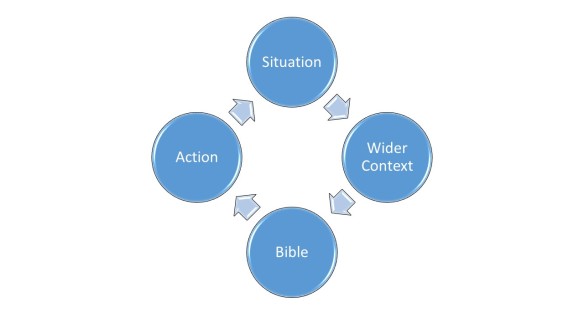
It is impossible to reflect properly about every moment that occurs. I’m not advocating constant reflection. There is plenty of time for action. But in a society of ‘activism’ has reflection disappeared?
Reflection is particularly helpful in times of trouble, or when issues arise. Going to Cambodia, I suspect this will be the case more so than usual as we learn to live in another culture different from ours. The tool I’ve found helpful (taught during my time in Melbourne), helps us navigate these tricky times. It’s not fool proof. But it’s worth it.

Often when faced with a new situation or problem we go straight to action. This is partly from our activist culture that works on doing things and doing them quickly; time is money. Now sometimes this is necessary and we can’t always take time to reflect. But that doesn’t mean we never should. The reflection cycle, shown to us recently at St Andrews Hall, begins with the situation or event.

We spend time seeking to understand the ins and outs of that situation. This is important and will pay off in the rest of the cycle. We then move to the wider context (factors that may not be readily apparent, but played a part in the situation). This provides the base to head to Scripture in order to set our situation within God’s Word.1 These parts together help us then move to action, rather than moving to action straight away.2
As an example: In relationship difficulties… of which I never have any… the first step is understanding the situation as fully as we can. The second step is figuring out what lies behind the situation that may have effected things or may provide the rationale for actions and reactions (in relationships these factors are things like moods, energy levels, certain perspectives and personalities, yada, yada, yada). Having thought through these aspects, then its time to move to theological reflection. Theological reflection is only beneficial at this stage if we have done the last two stages properly.3 If we jump straight to this one, we get a similar result as if we had jumped straight to action. On the back of those three steps we are finally ready (as we can be) for action.
The real benefit in this reflection process is as much in the understanding as it is in the process. The reflection cycle does two things. Firstly, it slows us down (haste often leads to hate). And secondly, it helps us to see things from a wider perspective. Always healthy, in my opinion.
Next post, I’ll seek to apply these insights to our particular cross-cultural adventure.
- Here we were encouraged to go to narrative as opposed to argument. The reason being is that it is harder to pick stories prove our point of view. Instead, often narrative provides a challenge that enlarges our perspective on events or situations. ↩
- The assumption is that prayer is part of action, prayerful action. ↩
- Theological reflection that has skipped the first two steps will probably be reinforcing our particular reasoning for action, had we just gone straight to action. The first two steps open us up and prepare us to hear God’s Word (another, and the ultimate perspective). ↩

Pingback: Mission hypothesis #7b: The Reflection Cycle spinning |